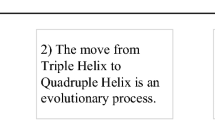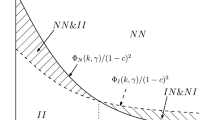Abstract
We consider the stochastic control model with finite time horizon for a mixed duopoly Research and Development (R&D) race between the profit-maximizing private firm and welfare-maximizing public firm. In our two-firm stochastic control R&D race model with input and output spillovers, the stochastic control variable is taken to be the private firm’s rate of R&D expenditure and the hazard rate of success of innovation has dependence on the R&D effort and knowledge stock. Given the fixed R&D effort of the public firm, the optimal control is determined so as to maximize the private firm’s value function subject to market uncertainty arising from the stochastic profit flow of the new innovative product. We conduct various sensitivity tests with varying model parameters to analyze the effects of input spillover, output spillover and knowledge stock on the optimal control policy and the value function of the profit-maximizing private firm. The R&D effort of the private firm is found to increase when the profit flow rate increases. Moreover, the optimal R&D effort level may decrease with increasing private firm’s knowledge stock and output spillover. The effects of input spillover on the optimal control policy and value function are seen to be relatively small. We examine the robustness of various observed phenomena of the two-firm R&D race with varying values of the fixed R&D effort of the public firm. With regard to public policy issue, we examine the level of the fixed public firm’s R&D effort so that social welfare is maximized.




Similar content being viewed by others
References
Amir, R.: Modelling imperfectly appropriable R&D via spillovers. Int. J. Ind. Organ. 18(7), 1013–1032 (2000)
Barles, G.: Convergence of numerical schemes for degenerate parabolic equations arising in finance. In: Rogers, L.C.G., Talay, D. (eds.) Numerical methods finance, pp. 1–21. Cambridge University Press, Cambridge (1997)
d’Aspremont, C., Jacquemin, A.: Cooperative and noncooperative R&D in duopoly with spillovers. Am. Econ. Rev. 82(5), 1133–1137 (1988)
Delbono, F., Denicolò, V.: Regulating innovative activity: the role of a public firm. Int. J. Ind. Organ. 11(1), 35–48 (1993)
Doraszelski, U.: An R&D race with knowledge accumulation. RAND J. Econ. 34(1), 20–42 (2003)
Forsyth, P.A., Labahn, G.: Numerical methods for controlled Hamilton–Jacobi–Bellman PDEs in finance. J. Comput. Finance 11(2), 1–44 (2007)
Gil Moltó, M.J., Poyago-Theotoky, J., Zikos, V.: R&D subsidies, spillovers and privatization in mixed markets. South. Econ. J. 78(1), 233–255 (2011)
Giovanni, D.F., Delbono, F.: Game theoretic models of mixed oligopoly. J. Econ. Surv. 4(1), 1–17 (1990)
Hausenschild, N.: On the role of input and output spillovers when R&D projects are risky. Int. J. Ind. Organ. 21(8), 1065–1089 (2003)
Ishibashi, I., Matsumura, T.: R&D competition between public and private sectors. Eur. Econ. Rev. 50(6), 1347–1366 (2006)
Kamien, M.I., Muller, E., Zang, I.: Research joint ventures and R&D cartels. Am. Econ. Rev. 82(5), 1293–1306 (1992)
König, M.D., Battiston, S., Napoletano, M., Schweitzer, F.: Recombinant knowledge and the evolution of innovation networks. J. Econ. Behav. Organ. 79(3), 145–164 (2011)
Leung, C.M., Kwok, Y.K.: Numerical algorithms for R&D stochastic control models. J. Comput. Finance 18(1), 1–21 (2014)
Marinucci, M.: Cooperative R&D networks among firms and public research institutions, Bank of Italy Temi di Discussione (Working Paper) No. 962. (2014)
Martin, S.: Spillovers, appropriability, and R&D. J. Econ. 75(1), 1–32 (2002)
Naseem, A., Oehmke, J.F.: Spillovers, joint ventures and social welfare in a mixed duopoly R&D, American Agricultural Economics Association 2006 Annual meeting, July 23–26, Long Beach, CA (2006)
Pawlina, G., Kort, P.M.: Real options in an asymmetric duopoly: Who benefits from your competitive disadvantage. J. Econ. Manag. Strategy 15(1), 1–35 (2006)
Poyago-Theotoky, J.: R&D competition in a mixed duopoly under uncertainty and easy imitation. J. Comp. Econ. 26(3), 415–428 (1998)
Steinmetz, A.: Competition, innovation, and the effect of knowledge accumulation, Wüzburg Economic Papers, No. 81 (2010)
Zikos, V.: Equilibrium and optimal R&D roles in a mixed market. Working Papers (Economics) (2007)
Acknowledgments
The work was supported by the Hong Kong Research Grants Council under Project 602313 of the General Research Funds.
Author information
Authors and Affiliations
Corresponding author
Appendix: Derivation of \(C_{1} (\tau ; z_{1} )\) and \(C_{2} (\tau ; z_{1} )\), \(\tau =T-t\)
Appendix: Derivation of \(C_{1} (\tau ; z_{1} )\) and \(C_{2} (\tau ; z_{1} )\), \(\tau =T-t\)
It is convenient to use \(\tau =T-t\) as the temperal variable in \(C_1\) and \(C_2\). To determine \(C_{1} (\tau ; z_{1} )\) and \(C_{2} (\tau ; z_{1} )\), we substitute Eq. (2.6c) into the HJB formulation and obtain the following governing partial differential equations for \(C_{1} (\tau ; z_{1} )\) and \(C_{2} (\tau ; z_{1} )\):
The above equations share the following general form:
where \(h(\tau ; z_{1} )\) and \(k(\tau ; z_{1} )\) are functions of \(\tau \) and \(z_{1}\). Here, \(a\) is constant (\(u_0\) is constant and \(u_1\) is also fixed by adopting \({\mathrm {sup}}~Q_1\)). The general solution of Eq. (6.1) is given by
where
and \(\phi (u)\) is an arbitrary function to be determined from appropriate auxiliary conditions. Since \(C_1 (0; z_{1} )=0\) and \(C_2 (0; z_{1} )=0\), we obtain \(\phi _{1} (u)=\phi _{2} (u)=0\). Therefore, the solution to Eq. (6.1) is found to be
Rights and permissions
About this article
Cite this article
Wang, J., Leung, C.M. & Kwok, Y.K. Stochastic control model for R&D race in a mixed duopoly with spillovers and knowledge stocks. Decisions Econ Finan 38, 177–195 (2015). https://doi.org/10.1007/s10203-015-0163-z
Received:
Accepted:
Published:
Issue Date:
DOI: https://doi.org/10.1007/s10203-015-0163-z




